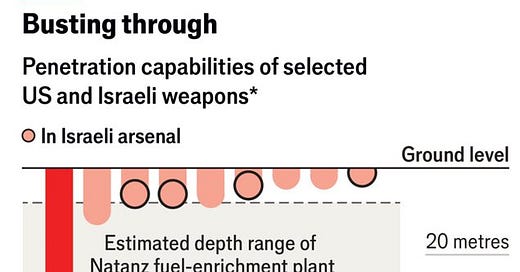Keep in mind with this infographic that it rests on dubious assumptions. The most important assumption is that the target below ground lies at the end of a basically straight shaft. But that is reportedly not the case with the Iranian nuclear facilities. That means that multiple strikes would be required if the exact underground location cannot be located precisely—because the actual explosion would need to be very close to the buried facility. Another assumption is that the explosive projectile would descend in a straight line. This is far from certain, due both to the mountainous terrain as well as to defensive underground structuress designed to deflect any explosive projectile from a straight course. These are some of the reasons—in addition to the depths involved—that the effectiveness of such explosive devices is highly uncertain:
America’s huge bunker-busting bomb is not sure to work in #Iran. https://economist.com/graphic-detail/2025/06/18/americas-huge-bunker-busting-bomb-is-not-sure-to-work-in-iran…
Caveat. There’s undoubtedly much more that could be said, and I’m not a scientist. However, this sounded reasonable:

Wolfgang Alt @_walt_1
12h
#Iran underground weapon factories.
Question: Can these large US bombs destroy them?
The mass and inertia of base rock is huge.
The rock crumbles and breaks at the point of impact and that causes a field of shock-absorbing material. The fractured material "automatically" distributes forces in a way so that "work" gets minimized.
I.e., the fractured material absorbs the explosive forces and directs them away from the actual task of the explosion.
Answer:
 Sensitive equipment in the tunnels is destroyed locally, but not the general tunnel infrastructure.
 Enriched uranium/plutonium gets buried, but can be dug out again any time.
The only safe way to disable Iran's underground factories is to go in, manually remove the hazardous material, and demolish the tunnels one by one.
AirPower 2.0 (MIL_STD) @AirPowerNEW1
Good .
But what's advertised & publicly known, is unlikely to be full extent of US capability to attack deeply buried & fortified targets. This threat has existed for decades, and so have efforts to develop/field capabilities to defeat it. We don't know what we don't know.
I’m going with Ted Postol’s explanations. Apparently Trump’s hesitations are based on arguments similar to Postol’s. That would also mean that, whether or not the general public has accurate knowledge about the full extent of current US capabilities, even the military experts have serious doubts.




Scott Ritter @RealScottRitter
9h
Ted Cruz, an ostensible “Christian”, takes his cue from Genesis, an acknowledged work of Jewish fiction, rather than Jesus.
What would Jesus do? Ted Cruz has no clue. Neither do any of the so-called “Christian Zionists.”
I do.
And it wouldn’t have anything to do with going to war in support of Israel.
In Ukraine, there are numerous documented cases of Russia AD interdicting JDAMs in flight. The GBU 57B is much larger than a JDAM and has an enormous radar signature. Assuming a B2 can get over the target and release, there is a reasonable probability that Iran may also be able interdict it in flight. It wouldn't surprise me if Russian AD specialists have already training their Iranian counterparts in this technique. Both Russia and Iran will go to school on how to interdict this particular munition and then write the book on it for future warfare situations. They are also collecting a lot of data on the radar profile of an F-35 in combat situations. All of this knowledge will be used against Western armed forces in future conflicts.